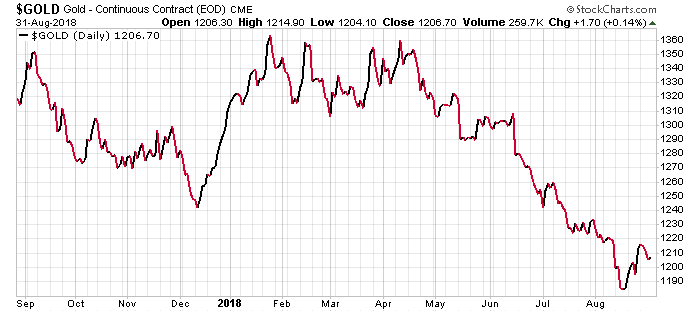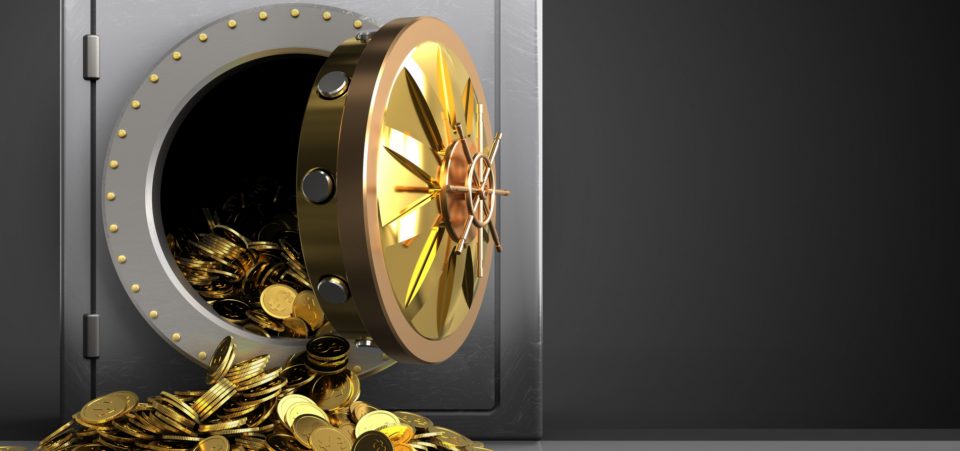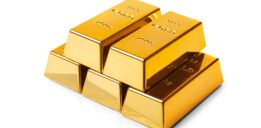Change in Fed Plans Isn’t Only Factor Pushing for Higher Gold Prices
Federal Reserve Chair Jerome Powell recently delivered some choice words at Jackson Hole, Wyoming. He signaled a reconsideration of the Fed’s interest rate policy.
Interest rates now may not increase as much as expected. That means a few things, but as far as investing in precious metals is concerned, it suggests that gold prices will start bouncing back faster than anyone expected.
Unfortunately, some investors will simply use the revised, more dovish, interest rate trend to double down on higher-risk investments like equities. They will follow the standard logic whereby lower interest rates will stimulate the markets.
The indices will rise again, pushing stocks on Wall Street to new highs, perhaps surpassing the lofty heights achieved in January, with major upside technical violations carried out by the S&P 500 and the Nasdaq.
Or perhaps not.
Logic Will Return to the Markets
Certainly, if logic returns to the markets, many stocks will collapse. At the same time, a return to logic would also boost safe-haven investments.
With the all-but-definitive depression in Bitcoin and cryptocurrency valuations, gold and precious metals will regain their top safe-haven investment status and the price of gold will take a bullish turn.
Admittedly, the chance of gold prices rising may still appear as science fiction. After all, conditions have been favorable to gold for some time now.
And judging even by the latest gold rally (and its fizzling out) in August, even the most bullish of gold investors would find it difficult to remain optimistic.
Indeed, the rising trade tensions between the United States and China, not to mention the ones between the U.S. and Europe (and the ever more stressed geopolitical environment in general), the price of gold should have already gone up significantly.
Instead, investors have not tripped over themselves to grab safe-haven assets like gold or silver. The gold price has actually dropped, no matter how dire the effects of the 21st-century version of the trade wars might be.
More Lurks Behind the Scenes of the Latest Stunted Gold Rally
At the time of this writing, the price of gold had just picked up by a few dollars after its latest failed rally. As the chart below shows, gold prices have dropped to their lowest point in a year.

Chart courtesy of StockCharts.com
Yet the chart offers some encouraging hints. Notice that the recent gold price highs occurred in September 2017, March 2018, and April 2018. There’s a common denominator.
If there’s one thing that has propped up gold, it’s the threat of a conflict involving the Democratic People’s Republic of Korea (North Korea for short).
Yes, It’s North Korea
In the past 365 days, the threat of conflict with North Korea was highest precisely when tensions between Washington D.C. and Pyongyang intensified.
President Donald Trump’s meeting with North Korean leader Kim Jong-un last June may have lowered the chance of conflict. But it also caused a slump in gold prices.
Behold. Not all is lost. The chance of conflict has just intensified again. Not only have tensions between the U.S. and North Korea resumed, they are also more complicated.
Perhaps in the midst of the “Russiagate” investigation and the passing of Senator John McCain, few seem to have noticed that President Trump has asked Secretary of State Mike Pompeo to cancel his planned visit to Pyongyang.
I have asked Secretary of State Mike Pompeo not to go to North Korea, at this time, because I feel we are not making sufficient progress with respect to the denuclearization of the Korean Peninsula…
— Donald J. Trump (@realDonaldTrump) August 24, 2018
China Holds the Cards
In keeping with the trade war theme, President Trump has blamed China for having failed to facilitate the peace process between North Korea and the United States.
Beijing, admittedly, has no reason to cooperate with Washington, certainly now that Trump has shaken and stirred the principles of the World Trade Organization (WTO).
The Chinese are sending a clear message to Trump: Drop the trade tariffs and we shall cooperate with your North Korea plans.
For all of Trump’s ambitions and meetings with Kim Jong-un, prospects for peace in the Korean Peninsula necessarily pass through Beijing. The People’s Republic of China, in fact, has been the only country to have maintained close relations with North Korea. It’s the only one that can broker a long-lasting agreement (or avert a war, for that matter).
Yet, according to Trump’s negotiation approach, whereby he pushes—even bluffs—his adversaries into a corner, there’s no turning back from the trade war. Or at least Trump won’t back down ahead of the November mid-term elections.
A lot can happen between now and November.
Trump must play to his base. He will therefore continue to use a strong hand against China while allowing the promise of better relations with North Korea go by the wayside. After all, he can always claim that he tried with the Singapore summit.
Trump will also, given the political climate, continue to criticize higher interest rates and the related high U.S. dollar.
Encouraging Signs for Gold Prices
Given the Federal Reserve’s new reservations over its plan to further lift interest rates, Trump might score political points by conducting the kind of policies that will favor gold.
Gold should begin a steady recovery over the next few months. Many institutional investors, hedge funds, and the like have held bearish positions on gold.
Yet, a hiatus in the Fed’s interest rate policy will force gold bears to wake up and smell the storm that’s brewing over the equity markets. They will be encouraged to turn bullish on gold before it’s too late.
The U.S. dollar has served as the main factor influencing traders’ opinions, turning them against gold until now.
A Euro Crisis
The gold price appears to be meeting resistance around the $1,215-per-ounce mark.
If North Korea, a trade war, and a suddenly-bearish Federal Reserve aren’t sufficiently convincing triggers for gold prices to bounce back, consider then the euro.
One way or another, the euro and the eurozone could be stepping into a crisis. Italy has entered into a confrontation with the European Union over the migration crisis and the country’s debt levels. Meanwhile, the European Central Bank (ECB) announced that it would stop quantitative easing in 2019.
The latter move would reduce the strength of the U.S. dollar while increasing tensions in the eurozone, prompting a rush to safe-haven assets like gold.
Moreover, there’s the growing chance of a global recession that could not only stop the Federal Reserve from lifting interest rates, it could force the Fed to reduce them.
That would happen just as the ECB hikes its own interest rates, reversing the dollar’s gains over the euro.
At that point, the gold bears will have no cards left to play.






